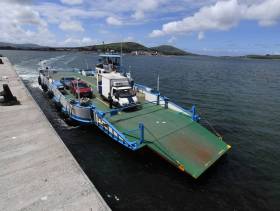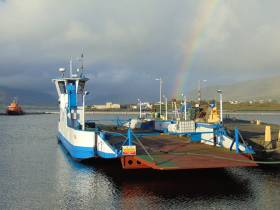Displaying items by tag: Valentia Island Ferries
Valentia Island: 'We Need Support to Save Our Ferry'
#islandnews - The Kerryman writes that the ferry service to Valentia Island is a vital asset to all south-west of the county and should be given the financial support it needs to continue into the future.
That was the view of Councillor Norma Moriarty at last week's meeting of the South and West Kerry Municipal District following a deputation by Valentia Island Ferries Limited.
The deputation spokesperson Muiris O'Donoghue explained that, through its own money and borrowings, the group currently has €1million of the €2.8million it needs for a new boat it has designed. While its current boat - a 1963-built craft that has operated every March to October in south Kerry since 1996 - is in good shape according to Mr O'Donoghue, the Marine Survey Office has said that the boat will have to be replaced in 2018.
The group has not secured funding from the Fáilte Ireland Capital Programme for larger project, and says it has done all it can to raise funds through its own initiative. An emergency meeting will take place in the coming weeks between Ministers Heather Humphreys, Michael Ring and Shane Ross to discuss approaches to securing the ferry's future.
Deputy Michael Healy Rae said no date is in place but that Minister Ross "wants it arranged as soon as possible".
For more from the local newspaper, click here.
Valentia Island Ferry Not Eligible Says Fáilte Ireland for Grant Aid
#islandnews- An island ferry says Fáilte Ireland cannot be included, such a new ferry was felt to be crucial for tourism in the South-West, among major projects eligible for grant aid.
As the Irish Examiner writes, EU rules governing state aid for tourism also prohibit aid for the Valentia Island ferry, it says.
The Valentia Island Ferry is of premium importance not just to tourists but serves locals too and is a key piece of infrastructure in the whole of south-west Kerry, a council meeting was told in Kerry this week.
Representatives from the five original families who came together 20 years ago against the odds to form the co-operative to put the ferry in place between the old capital Knightstown and the mainland near Cahersiveen, are campaigning for state funding to allow them replace the ferry with a bigger vessel.
“We are looking for the support of the council not just for Valentia, but for the development of tourism and the economy in the region,” ferry founder, Richard Foran, said in Killorglin.
Valentia is a regular day trip from Killarney now, because of the ferry. The ferry was instrumental in revitalising Knightstown, the old Victorian capital of Valentia.
A bridge which opened in 1971 from Portmagee linked the mainland with the far end of the island but many tourists prefer the ferry.
A new €2.8m ferry has been designed and the co-op will supply €1m, but needs the rest grand-aided, Mr Foran said.
For more on this story click here.






























































